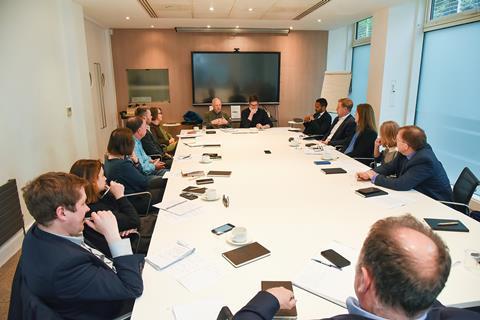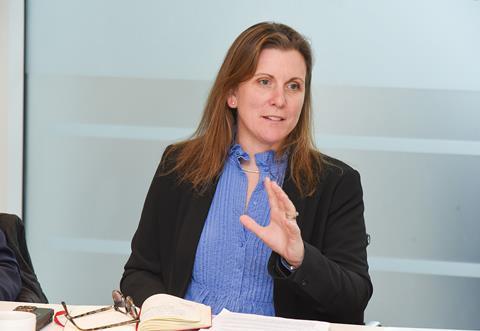Building gathers a group of Building the Future commissioners together for the first time to take soundings on ideas to improve the built environment

What is the most frustrating thing about working in the construction industry? Is it lengthy procurement processes, slow planning, the race to the bottom on price?, the lack of takeup of tech? Skills shortages? Perhaps it is the lack of progress on inclusivity or net zero? Or maybe something else entirely?

Since January this publication’s ambitious Building the Future Commission has been examining issues preventing the built environment from reaching its full potential. We’ve been looking at potential solutions and new thinking across eight work streams helped by our panel of 19 commissioners.
We wanted to get time in the diaries of our busy commissioners – who are all key figures from the world of business, policy, research and education – so we could bring them together in the same room with our editorial team and take soundings on the state of the built environment and what may be done to improve it.
The aim of hearing from the panel gathered at Gleeds’ offices in central London was to hear the germ of ideas that could help us on our journey towards coming up with a set of recommendations under a unifying theme in the commission’s final report, which will be produced after 12-months of work during this, our 180th anniversary year.
On the panel
The following Building the Future Commisisoners took part in the discussion:
- Andrew Mellor, partner,PRP
- Rebecca Rees, partner, Trowers & Hamlins
- Simon Tolson, senior partner, Fenwick Elliott
- Simon Wyatt, sustainability partner, Cundall
- Martha Tsigkari, Senior partner and head of the applied R+D group at Foster + Partners
- Katy Dowding, president and chief executive, Skanska
- Richard Steer, chair, Gleeds
- Mark Wild, chief executive, SGN,
- Kay Hughes, design director, HS2
- Neal Shasore, Head of school and chief executive of the London School of Architecture
This meeting was about sharing some initial thoughts and brainstorming of the challenges facing construction and what needs to change.
The race to the bottom
One of the first things our panel talked about in depth was the oft quoted “race to the bottom” on price, which been thrust into the spotlight by the 2018 Hackitt review and findings from the Grenfell Inquiry.
Rebecca Rees, partner at Trowers & Hamlins, said there is a need for what she describes as a “competent client”. She said: “We are still awarding complex contracts, where safety and quality are the desired outcomes, at the lowest price. To get traction or to move clients away from lowest price tendering has proved extraordinarily difficult.”

Rees said she has plenty of ideas of how alternative price models will work and is working on what she calls a “grumpy” piece for the commission on “alternative price evaluation models”. Watch this space.
Andrew Mellor, partner at PRP echoes Rees by saying that “we’ve got to start paying more for buildings” and also said there needs to be more oversight on safety and design quality.
A lot of this, the commissioners suggest, is due to a lack of long-term strategic thinking or buy-in, particularly from clients, although the panellists are keen to stress it is the whole “authorising environment” - referring more generally to senior leadership at the organisational level making decisions - that needs to change.
Simon Tolson, senior partner at Fenwick Elliott, added that we need “intelligent customers” who make sure a “long term commitment is taken”, which he said rarely happens, although the “ship is turning”.
For Katy Dowding, president and chief executive of Skanska, the race to the bottom reduces opportunities for productivity and innovation.
She also said the lengthy competitive tendering process and huge transactional costs mean the opportunity to introduce innovation has long been lost by the time the supply chain is employed.

Dowding added that there are particular problems in public sector projects. “There is this misconception that you get value for money through competition. And actually most of the time all that does is increase transactional costs, reducing the opportunity for creating value.”
She added that two-stage tendering processes – which is supposed to facilitate early contractor involvement under a pre-construction agreement before the actual contract is agreed – often do not work because “everyone pretends they can build it quicker and cheaper, and that they will work it out in the second stage but then the prices go up and the client realises their model doesn’t work anymore.”
Instead, said Dowding, genuine collaboration at an early stage, with the contractor also demonstrating the value of a contract, is needed.
Complexity
Procurement is far from the only area of complexity bedevilling the built environment, however.
Mark Wild, former boss of Crossrail and now chief executive of gas distribution giant SGN, said planning documentation around projects is getting more complex.
He cites anecdotal evidence that there were around 3,000 files in the development consent order (DCO) for the Hinkley Point nuclear power station, approved in March 2013, compared with 20,000 in the DCO for Sizewell issued last year.
Wild said there is a “mission creep of complexity”, which has been further added to by the fact that projects are getting bigger and increasingly need to meet net zero requirements.
Kay Hughes, design director of HS2, agreed and called for a “proper strategic planning network,” bringing together housing, energy and water infrastructure to help tackle the net zero challenge.
Hughes also pointed to complexity in documentation through transactions. “People are sending out documents that are 300 pages long, and they are sending five of them and expecting somebody to come back…that’s crazy, it’s not sensible, it is not something that the human brain can absorb.”
AI and data
Human brains may struggle to absorb so much information, but the expectation surely is that artificial intelligence may be able to lend a considerable helping hand in the not-too-distant future. AI is a major part of the Building the Future Commission’s project delivery and digital stream and we have already looked at several potential major implications of its use as part of our AI Week earlier this month.

Martha Tsigkari, senior partner and head of the applied research and development group at Foster + Partners, warned the industry and regulators have much to do to improve their understanding of data to ensure AI can be used to its full potential.
She said: “Nobody knows how much data they have. Nobody knows how to deal with it. And yet we’re going to be making very significant decisions based on that data.
“Nobody knows the quality of the data and yet it’s going to drive decisions through AI processes that are going to affect every single one of us.” She added.
Tsigkari believed we lack a regulatory framework for governing the use of data.
She said: “In the very near future we are going to be seeing entire systems that can deliver a Revit model, for instance, for a building based on AI-trained systems with data that is not contextualised and doesn’t comply with structural regulations.”
Tsigkari said dealing with legal issues around the use of data and who owns it could become a real issue for the industry. She also said that there is little regulation around the use of robotics on construction sites and understanding of how humans and robots can work together operationally safely and legally.
The panel could all see the potential of tech in improving our understanding of buildings.
Tolson pointed to energy efficiency as an example. He said data “can be collected much more intelligently by the Internet of Things and by using artificial intelligence to understand how our buildings use energy, how they consume energy and how energy can be conserved.”
Tolson however thinks there needs to be a focus on this to ensure the benefits are “structured” and not “haphazard.”
Net zero
While rapidly advancing technology may help the industry understand the energy efficiency of buildings, a much bigger question surrounds the issue of how construction sees the net zero agenda.
“There seems to be a lack of will or desire in the industry to re-use and reutilise,” said Simon Wyatt, sustainability partner at consultancy Cundall.
“One of the best examples is that every five to 10 years the office is refitted and [air conditioning] units are taken out and thrown in the skip, whereas all you have to do is change the motor and the controllers and you save 90% of the carbon.”
Yet again, the finger is pointed at the industry’s short-termism, but Wyatt said upskilling can help tackle this.
“Developers need upskilling. I think the entire industry needs to be aware because again, design teams are very much focused on [how] net zero is going to be extra cost”, he said.
“Clients don’t want to pay it but ultimately when you do a live costing, and look at the whole lifecycle of a project, if you build so you need to go and retrofit within five to 10 years, it’s an absolute waste of money and time and you’re losing continuation of business.”
Wyatt points out that greater regulation of financial institutions’ ESG credentials is coming along the line following COP26, which are intended to prevent “greenwashing”. This may focus minds on the topic.
Whole systems thinking and modularity
The need for construction to take into account carbon and energy efficiency impacts will only increase, but net zero is just one factor developers should take into account.
Wild said “whole systems thinking” should be adopted in construction, where thought is given at the design stage as to how different elements, including operators of the building and its environment, will interact with buildings.

Wild suggested modularisation can help deliver this in an industry that has in Wild’s words “an inability to narrow the productivity problem”, which he suspects is a reason why the new hospitals programme has yet to take off.
“My idea would be design for manufacture and assembly (DFMA) from a systems view, could we build in net zero, could you build to it take into account how operators will operate the system?” he says.
“There are less competent clients complexifying, we need more competent clients simplifying and modularising” he says.
The role of government
More competence among clients is surely to be welcomed, but when it comes to big infrastructure projects particularly, where government is the client, Wild accepts it is difficult to attract highly-skilled staff into government departments when the private sector pays more.
Tolson suggested the government has become a less “educated” client as a result of the abolition of the Property Services Agency in 1993 and has had to “re-learn” lessons about procurement.
Other panellists point to the revolving door of ministers, across many briefs including housing, construction and energy, as a factor meaning it is difficult to train ministers before they are moved on.
More broadly, the panel seemed to agree that construction needs a much stronger voice at the heart of government, whether that be an individual or a committee.
Chloe Mcculloch, editorial director of Building, asked the commissioners for their views on introducing an appointment at government level, either a body or an individual “construction tsar”, that champions the industry.
“What you seem to be saying is that construction is consistently not prioritised at government level, and it falls between the cracks because the nature of the industry is fragmented, even though it is very important for the economy,” she said.
Wild, pointed to the National Infrastructure Commission and the Committee on Climate Change as examples of non-partisan, enduring public bodies that advise the government in an independent way.
“There’s no equivalent for construction,” says Wild. “The Construction Leadership Council is a good body and I’m sure they have great people but they are a lobby group rather than being on the inside.”
Skills
Whether talking about the ability of government, or knowledge of data and net zero, so much of what the commissioners talked about comes back to ensuring sufficient skills levels in the industry,

Richard Steer, chair of Gleeds, said that construction firms train people to do a trade but then often leave them to just “do their trade” rather than upskilling them further. The Building the Future Commission’s young person’s panel met on the same day as the commissioners and came up with some ideas to improve the skilling situation (LINK TO JORDY’S PIECE HERE)
Neal Shasore, head of school and chief executive of the London School of Architecture, also talked about the need for broadening skills and learning across different built environment disciplines. He talked to the group about the need for “stackable and modular learning from professionals cradle to grave across a whole span of disciplines”.
He said the aim would be to create “possibilities for people to move with much greater agility across the sector and thereby promote greater understanding amongst and respect amongst different disciplines.”
In the space of less than an hour and half the commissioners have raced through a wide variety of topics affecting the built environment in a discussion later described as “thought-provoking and intense” by Rees.
Key lines of enquiry to explore
- What would be the benefits construction of having a voice in government? What should it look like? Either an individual or an independent government body or agency?
- What might a spatial planning framework look like?
- What should be done to improve data collection and knowledge in preparation for the great AI revolution?
- How do we get around the “race to the bottom”? How do we embed longer-term thinking in procurement among clients?
- How can government boost its own skills and capability as a client?
- What barriers are there to whole system thinking being adopted in construction?
- How do we simplify procurement and planning processes?
The large amount of ground covered in this meeting, and over our recent coverage for the commission, enables us to see the direction of travel in the coming months.
Our soundings reveal an industry that needs to simplify and focus more on the long term, with different factors other than price driving procurement decisions.
The industry is crying out for need more strategic thinking, more support and vision for construction in the heart of government, more “intelligent’ clients - including more skilled and better resourced government clients with clear investment plans - more national spatial planning and a realisation of the importance of ESG investment and the potential (and dangers) of using technology and data.
In short, the commissioners want to see an end to short termism and more of a longer-term view, both among the industry and in Whitehall and the regions.
Over the coming weeks and months the commission will work to flesh this thinking out more.
The Building the Future Commission
The Building the Future Commission is a year-long project, marking Building’s 180th anniversary, to assess potential solutions and radical new ways of thinking to improve the built environment.
The major project’s work will be guided by a panel of 19 major figures who have signed up to help shape the commission’s work culminating in a report published at the end of the year.
The commissioners include figures from the world of contracting, housing development, architecture, policy-making, skills, design, place-making, infrastructure, consultancy and legal. See the full list here.
The project is looking at proposals for change in eight areas:
- Education and skills
- Housing and planning
- Energy and net zero
- Infrastructure
- Building safety
- Project delivery and digital
- Workplace culture and leadership
- Creating communities
>> Editor’s view: And now for something completely positive - our Building the Future Commission
>> Click here for more about the project and the commissioners
Building the Future is also undertaking a countrywide tour of roundtable discussions with experts around the regions as part of a consultation programme in partnership with the regional arms of industry body Constructing Excellence. There is also a young person’s advisory panel.
We are inviting readers to submit ideas for how to improve the built environment through our online form which will form part of our Ideas Hub.




























No comments yet